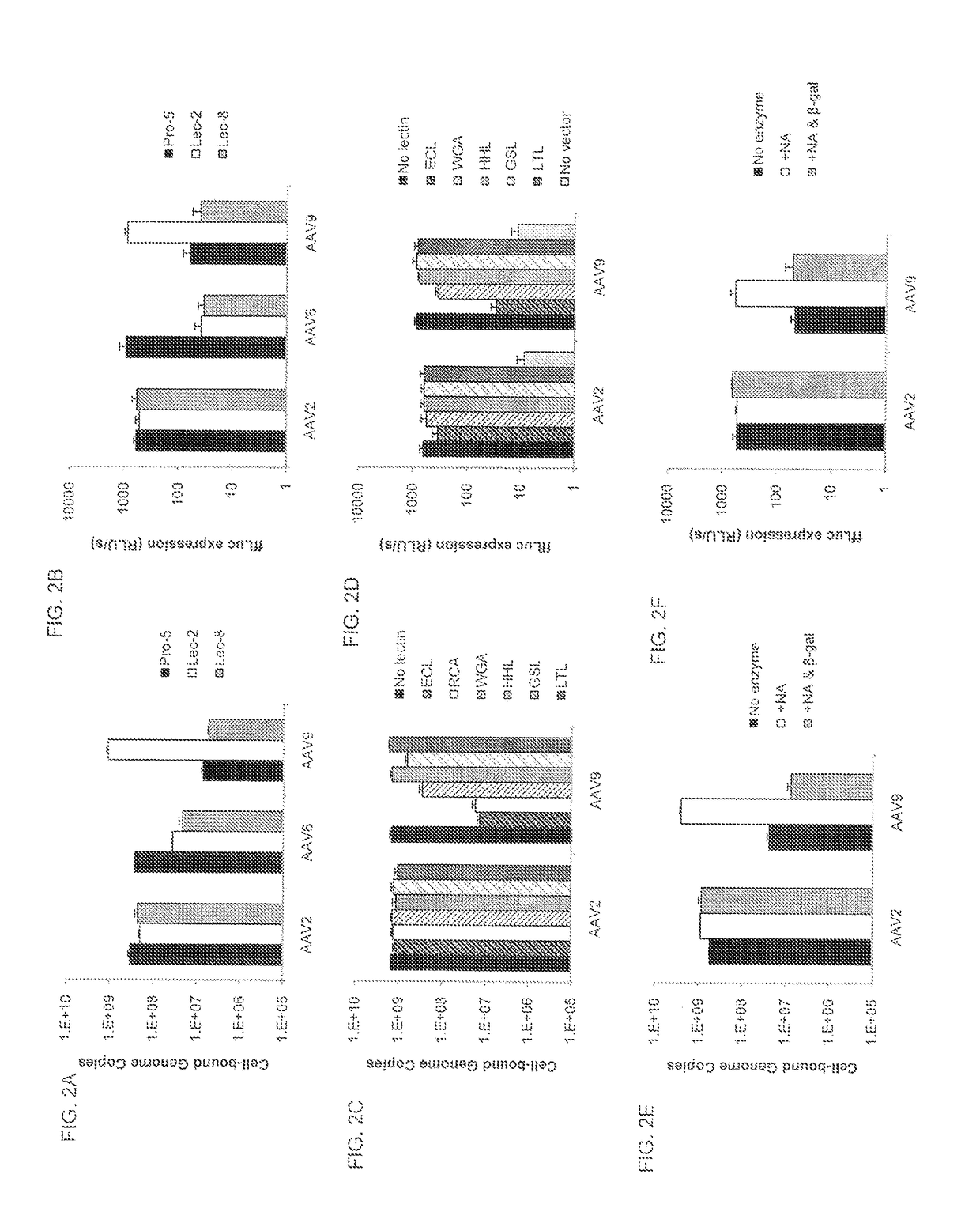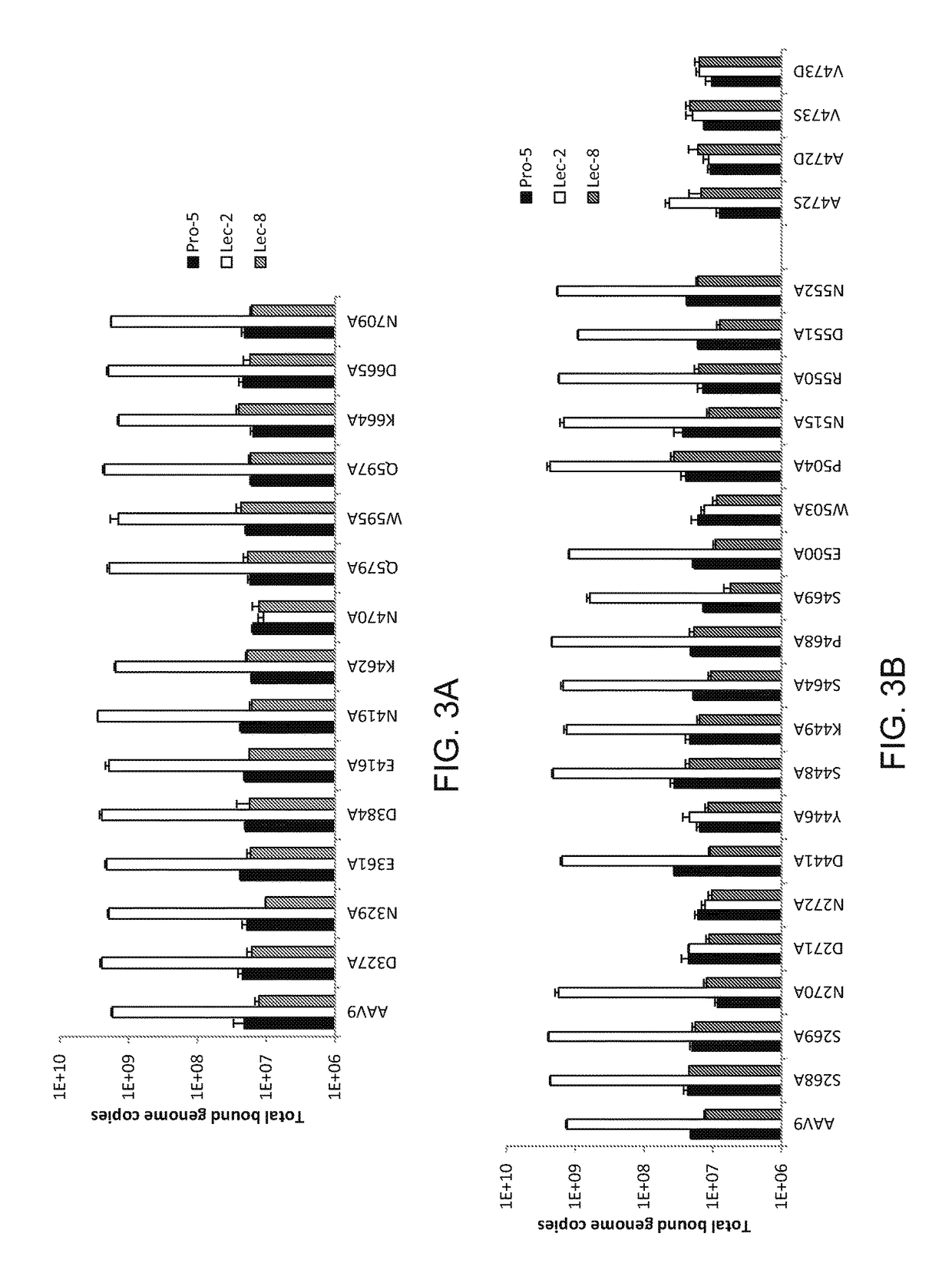Compositions and methods for altering tissue specificity and improving AAV9-mediated gene transfer
a technology of tissue specificity and gene transfer, which is applied in the direction of drug compositions, peptide sources, peptide/protein ingredients, etc., can solve the problems of toxicity to cells and non-use of rca in transduction studies, and achieve the effects of reducing or eliminating aav uptake, increasing the efficiency of aav uptake, and increasing the availability of -galactos
- Summary
- Abstract
- Description
- Claims
- Application Information
AI Technical Summary
Benefits of technology
Problems solved by technology
Method used
Image
Examples
example 1
Cell Binding and Transduction Assays
[0125]A. Binding Assays
[0126]For binding assays, cells were scraped from 150 cm2 flasks and seeded onto 96-well plates at 5×105 cells / well in 100 μl cold serum-free (SF) media. AAV vectors were produced as previously described by Penn Vector (www.med.upenn.edu / gtp / -vector_core.shtml) and were added at 5×109 genome copies (GC) / well in 100 μl cold SF media and incubated at 4° C. for 1 hr. Cells were washed three times with SF media and resuspended in 200 μl PBS. Total DNA was extracted using the QIAamp DNA Mini kit (QIAGEN). Cell-bound GCs were quantified by real-time PCR. Primers and probe used were complementary to the SV40 polyA sequence of the vector genome. F primer: AGCAATAGCATCACAAATTTCACAA [SEQ ID NO: 2]; R primer: CCAGACATGATAAGATACATTGATGAGTT [SEQ ID NO: 3 ]; TaqMan probe: 6FAM-AGCATTTTTTTCACTGCATTCTAGTTGTGGTTTGTC [SEQ ID NO: 4]-TAMRA. For cell transduction assays, cells were seeded at 105 cells / well in black-walled, clear-bottom 96-well p...
example 2
Glycosidase Treatment and Lectin Competition
[0131]Pro-5 cells were treated with 50 mU / ml of NA type III from Vibrio cholerae (Sigma) in 100 μl SF media or control cells with media alone for 2 hrs at 37° C. Some cells were then additionally treated with 60 mU / ml β-(1,4)-galactosidase in 50 μl reaction buffer (Sigma) or control cells with reaction buffer alone for 3 hrs at 37° C. Cells were then washed three times before the binding and transduction studies, as described above. For lectin competition studies, Pro-5 cells were first treated with NA to remove sialic acid. Cells were washed with cold SF media and lectins were added at 50 μg / ml in 100 μl SF media or media alone as a control and incubated at 4° C. for 15 min. The lectin solution was then removed and a mixture of AAV vector (5×109 GC for binding assays and 109 GC for transduction assays) and 50 μg / ml lectin or vector alone as control was added and incubated at 4° C. for 1 hr. Cells were then washed and analyzed for AAV bind...
example 3
Screening of Glycan Binding Specificity of AAV9
[0132]For glycan microarray (GMA) binding studies virus like particles (VLPs) of AAV9 were prepared using the Bac-to-Bac baculovirus expression system / Sf9 expression system as previously described [Mitchell, et al, 2004, PLoS Biol 2(8): E234] and screened in a high-throughput glycan microarray developed by Cores D and H of the Consortium for Functional Glycomics (CFG; an NIH National Institute of General Medicine Science Initiative). The printed array (Mammalian Printed Array [PA] V4.1, www.functional-glycomics.org / static / consortium / resources / resourcecorehl14.shtml) was composed of 465 different natural and synthetic mammalian glycans, including sialylated sugars with different linkages and modifications which was generated using amine coupling to covalently link amine-functionalized glycans or glycanconjugates to an amine-reactive N-hydroxysuccinimide-activated glass slide. A printed slide, containing six replicates per glycan or glyco...
PUM
| Property | Measurement | Unit |
|---|---|---|
| volume | aaaaa | aaaaa |
| volume | aaaaa | aaaaa |
| excitation emit wavelengths | aaaaa | aaaaa |
Abstract
Description
Claims
Application Information
 Login to view more
Login to view more - R&D Engineer
- R&D Manager
- IP Professional
- Industry Leading Data Capabilities
- Powerful AI technology
- Patent DNA Extraction
Browse by: Latest US Patents, China's latest patents, Technical Efficacy Thesaurus, Application Domain, Technology Topic.
© 2024 PatSnap. All rights reserved.Legal|Privacy policy|Modern Slavery Act Transparency Statement|Sitemap



